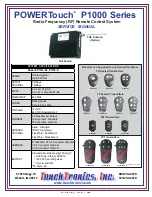
X
NST13308-P1000_A 2020-06-10
Page 2
Receiver Installation
Determine mounting location of receiver and
antenna - typically under the dash or behind a
wall.
Antenna Installation
1. The antenna must be installed in an open, non-
metal area in order to receive RF (radio
frequency) transmissions.
2. Antenna range will be reduced if located:
A) within 6 feet of a large motor
B) near large bundles of wires
C) near other RF devices
D) touching any metal
To Increase Antenna Range
A) Install exterior mount NMO Antenna
See page 4 for accessory antenna options
Each time a button is pressed on the transmitter, the corresponding output will turn On. For example, if button #1
is pressed, output #1 will turn On as long as the button is held.
If an input signal is sent to inputs A1 or A2, or any inputs B1 - B6, the corresponding output will turn On as long as
the signal is present. (A1 or B1 = Output #1 is ON. A2 or B2 = Output #2 is ON)
Each output is factory set as momentary. To change output from momentary to latching (push on / push off) see
DIP Switch options detail on page 3.
ENROLLING NEW TRANSMITTERS - Self-Learning Receiver
1. Remove and reconnect power to unit. This will place unit into LEARN mode for 5-seconds.
2. Press any button on transmitter once. Wait 5-seconds and confirm the transmitter has been enrolled by
pressing any button and verifying the correct output turned ON.
OR
1. Remove cover from receiver enclosure.
2. Locate LEARN switch
(*small, push-button style switch located in the corner of the printed circuit board)
.
3. Press and release the LEARN switch
The Red LEARN LED next to the switch will flash
4. Press any button on NEW transmitter.
6. Red LEARN LED double blinks to confirm enrollment.
7. Press any button on the new transmitter to confirm that the new transmitter code has been enrolled.
8. Replace receiver enclosure cover.
Erasing Enrolled Codes
1. Press and hold the LEARN switch
(*see # 2 above)
for 10-seconds.
2. Red status LED will flash while holding LEARN switch
3. Release LEARN switch when Red LED double flashes to confirm ALL transmitter codes are erased.
System Operation
Code Enrollment
Installation
1010-R6
Receiver
Model
6 - Relays
7 - Relays
12VDC
24VDC
30A Connector
Fixed Antenna
TNC Antenna
A1 &
A2
Switch Inputs
B1 - B6 Switch Inputs
Input Status LEDs
Receiver Model Number Chart
Page -2-
Special Order=SP
SP OPT
OPT
OPT
OPT
1030-R6
SP OPT
OPT






















